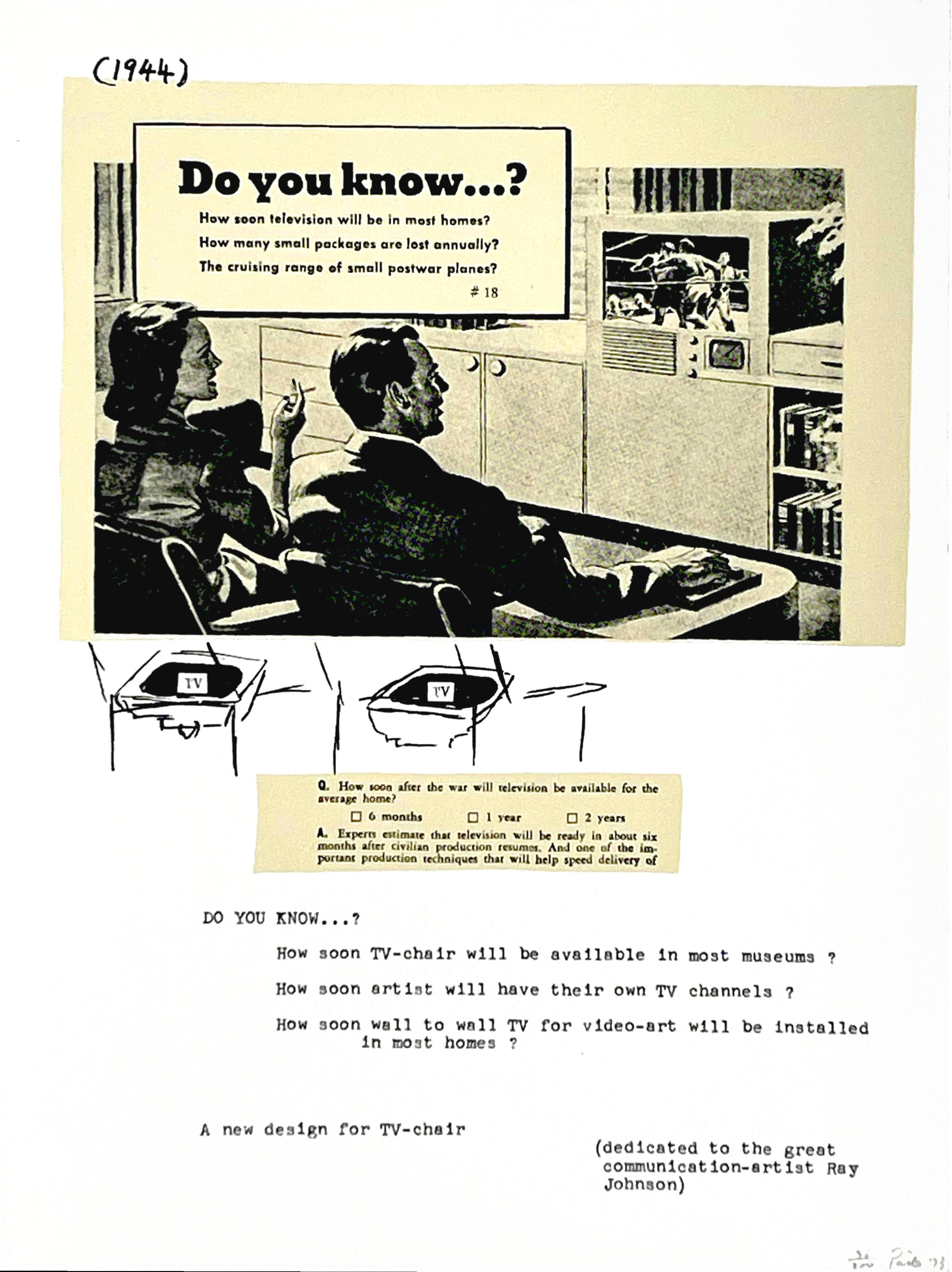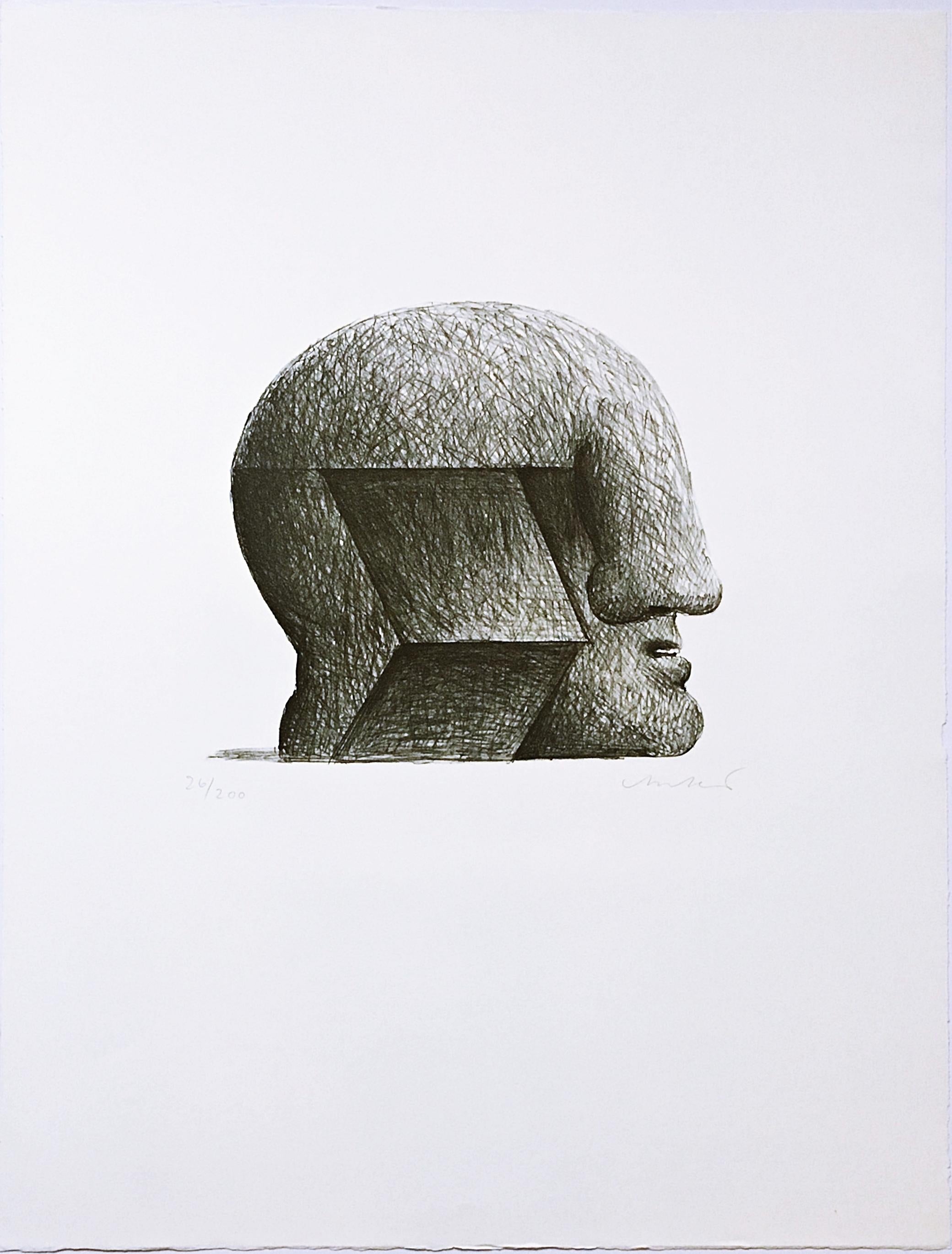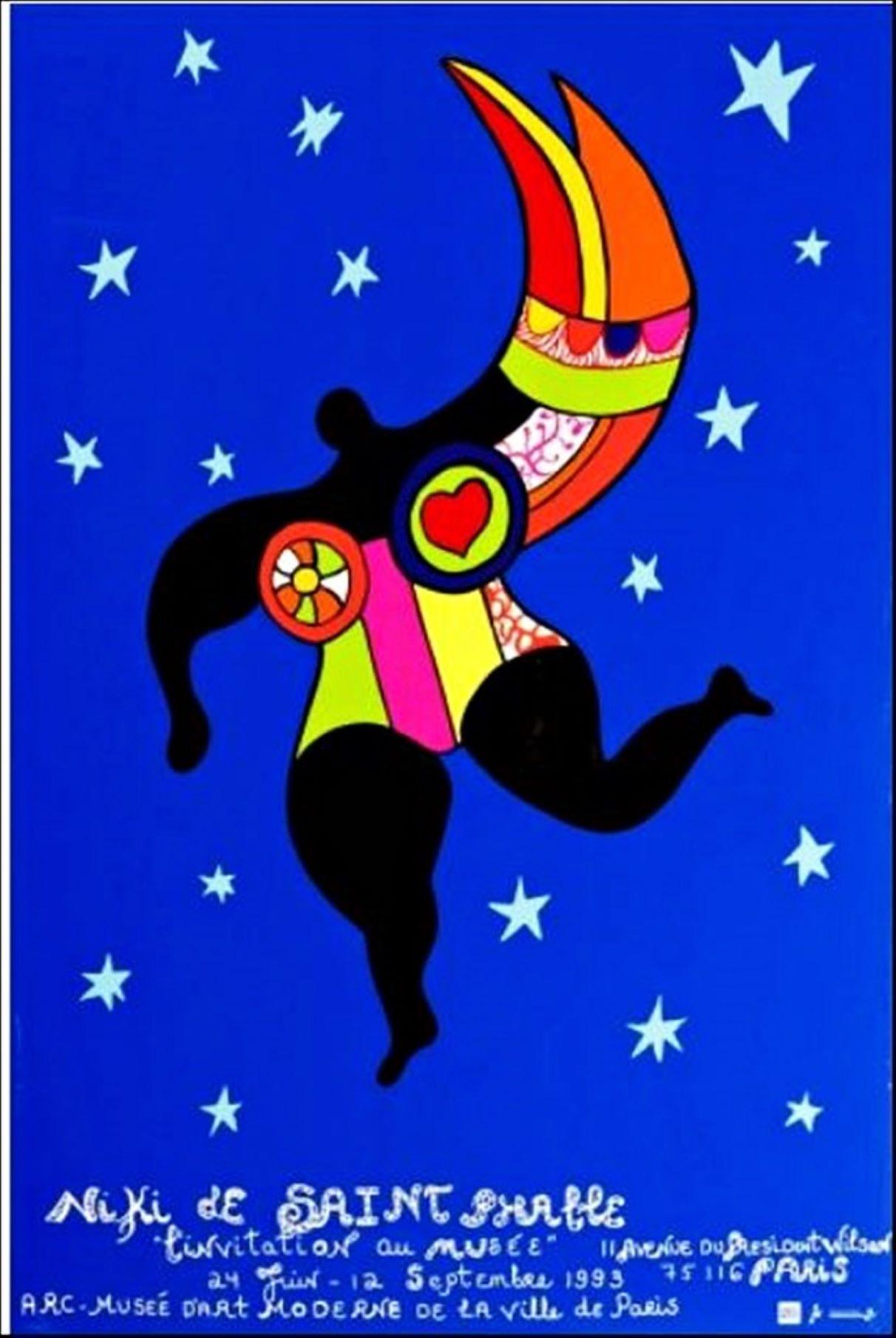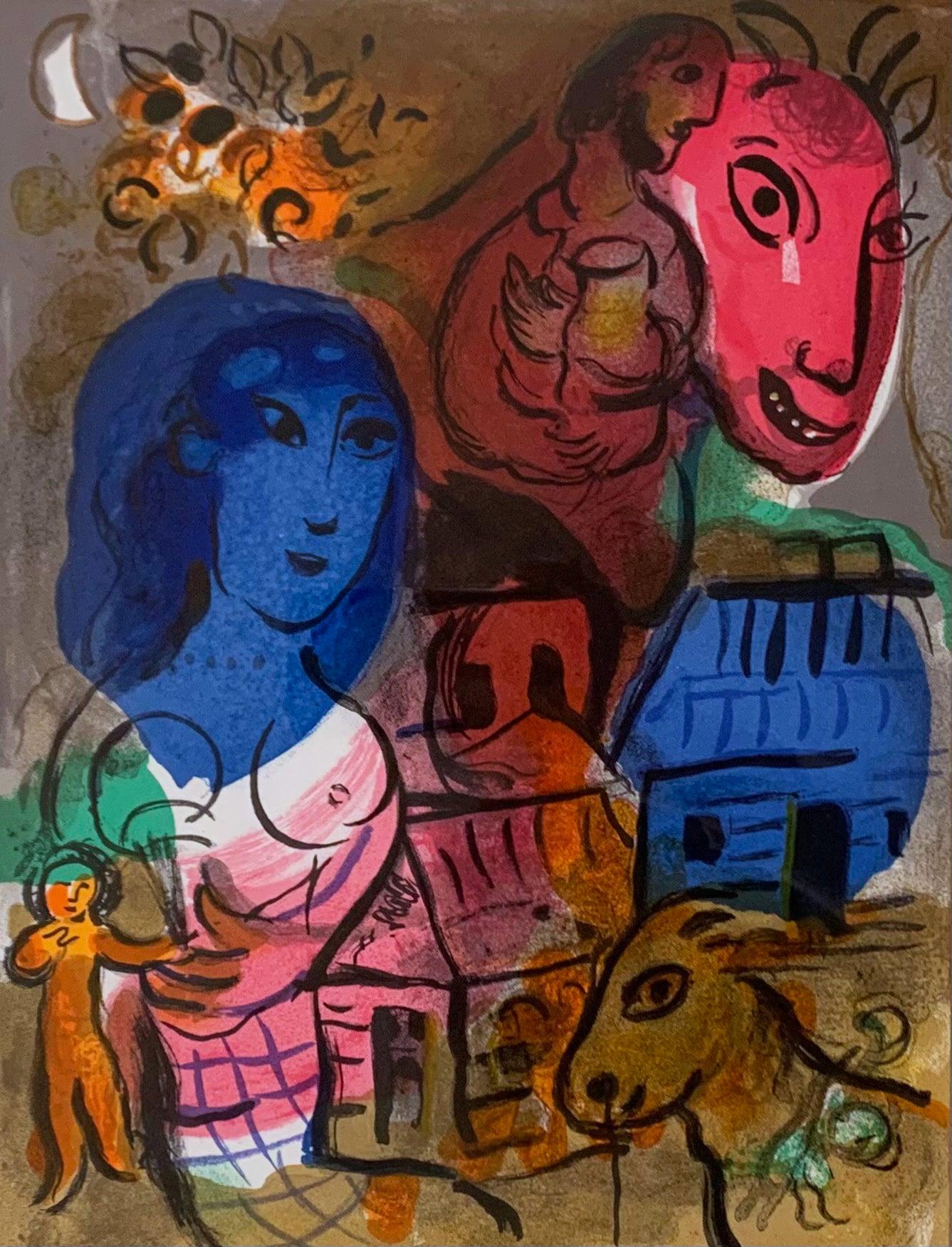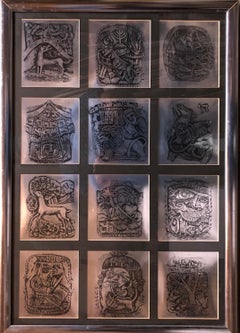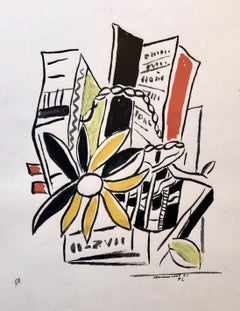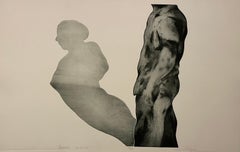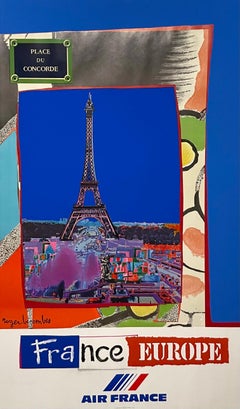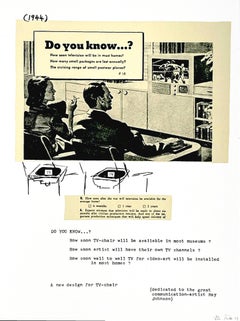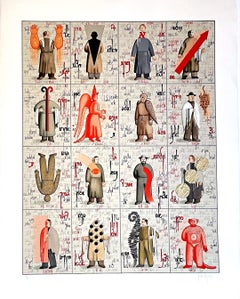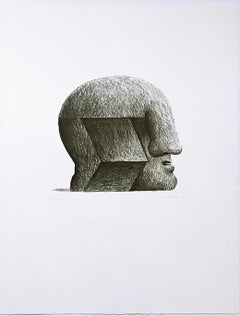Items Similar to In the style of Henry Moore, Mother and Child in Rocking Chair
Want more images or videos?
Request additional images or videos from the seller
1 of 16
UnknownIn the style of Henry Moore, Mother and Child in Rocking Chairc.1950s
c.1950s
About the Item
This is a cast metal sculpture of a woman and child, mother and baby in a rocking chair. It has a patina on a white metal. Not sure if it is steel or aluminum. It is and older vintage piece and has wear to patina where it sits and rocks on table. It is not signed or numbered and there is no foundry mark. Hence it is being sold as being after or in the manner of Henry Moore.
Henry Spencer Moore (1898 – 1986)
Moore was born in Castleford, the son of a coal miner. He became well-known through his carved marble and larger-scale abstract cast bronze sculptures, and was instrumental in introducing a particular form of modernism to the United Kingdom later endowing the Henry Moore Foundation, which continues to support education and promotion of the arts.
After the Great War, Moore received an ex-serviceman's grant to continue his education and in 1919 he became a student at the Leeds School of Art (now Leeds College of Art), which set up a sculpture studio especially for him. At the college, he met Barbara Hepworth, a fellow student who would also become a well-known British sculptor, and began a friendship and gentle professional rivalry that lasted for many years. In Leeds, Moore also had access to the modernist works in the collection of Sir Michael Sadler, the University Vice-Chancellor, which had a pronounced effect on his development. In 1921, Moore won a scholarship to study at the Royal College of Art in London, along with Hepworth and other Yorkshire contemporaries. While in London, Moore extended his knowledge of primitive art and sculpture, studying the ethnographic collections at the Victoria and Albert Museum and the British Museum.
Moore's familiarity with primitivism and the influence of sculptors such as Constantin Brâncuși, Jacob Epstein, Henri Gaudier-Brzeska and Frank Dobson led him to the method of direct carving, in which imperfections in the material and marks left by tools became part of the finished sculpture. After Moore married, the couple moved to a studio in Hampstead at 11a Parkhill Road NW3, joining a small colony of avant-garde artists who were taking root there. Shortly afterward, Hepworth and her second husband Ben Nicholson moved into a studio around the corner from Moore, while Naum Gabo, Roland Penrose, Cecil Stephenson and the art critic Herbert Read also lived in the area (Read referred to the area as "a nest of gentle artists"). This led to a rapid cross-fertilization of ideas that Read would publicise, helping to raise Moore's public profile. The area was also a stopping-off point for many refugee artists, architects and designers from continental Europe en route to America—some of whom would later commission works from Moore.
In 1932, after six year's teaching at the Royal College, Moore took up a post as the Head of the Department of Sculpture at the Chelsea School of Art. Artistically, Moore, Hepworth and other members of The Seven and Five Society would develop steadily more abstract work, partly influenced by their frequent trips to Paris and their contact with leading progressive artists, notably Pablo Picasso, Georges Braque, Jean Arp and Alberto Giacometti. Moore flirted with Surrealism, joining Paul Nash's modern art movement "Unit One", in 1933. In 1934, Moore visited Spain; he visited the cave of Altamira (which he described as the "Royal Academy of Cave Painting"), Madrid, Toledo and Pamplona. Moore made his first visit to America when a retrospective exhibition of his work opened at the Museum of Modern Art in New York City.[28]
Before the war, Moore had been approached by educator Henry Morris, who was trying to reform education with his concept of the Village College. Morris had engaged Walter Gropius as the architect for his second village college at Impington near Cambridge, and he wanted Moore to design a major public sculpture for the site.
In the 1950s, Moore began to receive increasingly significant commissions. He exhibited Reclining Figure: Festival at the Festival of Britain in 1951, and in 1958 produced a large marble reclining figure for the UNESCO building in Paris. With many more public works of art, the scale of Moore's sculptures grew significantly and he started to employ an increasing number of assistants to work with him at Much Hadham, including Anthony Caro and Richard Wentworth.
Moore produced at least three significant examples of architectural sculpture during his career. In 1928, despite his own self-described "extreme reservations", he accepted his first public commission for West Wind for the London Underground Building at 55 Broadway in London, joining the company of Jacob Epstein and Eric Gill. At an introductory speech in New York City for an exhibition of one of the finest modernist sculptors, Alberto Giacometti, Sartre spoke of "The beginning and the end of history" Moore's sense of England emerging undefeated from siege led to his focus on pieces characterised by endurance and continuity.
Yet Moore had a direct influence on several generations of sculptors of both British and international reputation. Among the artists who have acknowledged Moore's importance to their work are Sir Anthony Caro,[ Phillip King and Isaac Witkin, all three having been assistants to Moore. Other artists whose work was influenced by him include Helaine Blumenfeld, Drago Marin Cherina, Lynn Chadwick, Eduardo Paolozzi, Bernard Meadows, Reg Butler, William Turnbull, Robert Adams, Kenneth Armitage, and Geoffrey Clarke.
Moore presented 36 bronze and marble sculptures, as well as drawings, maquettes and other works to the Tate Gallery in 1978. He was involved in the School Prints scheme. The expensive endeavor peaked in 1949 with the magnificent European series, made possible by the plastic portable plates, which, in addition to Moore, featured Matisse, Picasso, Leger, Dufy and Braque
By the end of his career, Moore was the world's most successful living artist at auction. In 2012, his eight-foot bronze, Reclining Figure: Festival (1951) sold for a record £19.1 million at Christie's, making him the second most expensive 20th-century British artist after Francis Bacon
- Creation Year:c.1950s
- Dimensions:Height: 14 in (35.56 cm)Width: 13.5 in (34.29 cm)Depth: 6.25 in (15.88 cm)
- Medium:
- Movement & Style:
- Period:
- Condition:good condition with minor wear commensurate with age. some loss to patina where it touches the table.
- Gallery Location:Surfside, FL
- Reference Number:1stDibs: LU38213922102
About the Seller
4.9
Platinum Seller
Premium sellers with a 4.7+ rating and 24-hour response times
Established in 1995
1stDibs seller since 2014
1,744 sales on 1stDibs
Typical response time: 2 hours
- ShippingRetrieving quote...Shipping from: Surfside, FL
- Return Policy
Authenticity Guarantee
In the unlikely event there’s an issue with an item’s authenticity, contact us within 1 year for a full refund. DetailsMoney-Back Guarantee
If your item is not as described, is damaged in transit, or does not arrive, contact us within 7 days for a full refund. Details24-Hour Cancellation
You have a 24-hour grace period in which to reconsider your purchase, with no questions asked.Vetted Professional Sellers
Our world-class sellers must adhere to strict standards for service and quality, maintaining the integrity of our listings.Price-Match Guarantee
If you find that a seller listed the same item for a lower price elsewhere, we’ll match it.Trusted Global Delivery
Our best-in-class carrier network provides specialized shipping options worldwide, including custom delivery.More From This Seller
View AllMod 1970s Israeli Judaica Foil Print 12 Tribes of Israel Zodiac Signs Hebrew
Located in Surfside, FL
Genre: Israeli Batia Adith
Subject: Biblical
Medium: Print
Surface: Paper
Dimensions w/Frame: 30 1/2" x 21 1/2"
Category
1970s Modern Figurative Prints
Materials
Foil
Fernand Leger Colorful Modernist Drawing Limited Edition Serigraph Lithograph
By (after) Fernand Léger
Located in Surfside, FL
Serigraph, from ''Album of Ten Serigraphs'' (1954-55), by Fernand Leger (French 1881-1955), signed and dated in plate lower right, printed by Jean Bruller, distributed by Galerie Int...
Category
1950s Modern Abstract Prints
Materials
Lithograph
Modernist Figurative Pop Art Etching and Aquatint "the Artist" Michael Mazur
By Michael Mazur
Located in Surfside, FL
Michael Mazur
"The Artist"
Hand signed and editioned from the edition of 50
1967
Michael Burton Mazur (1935-August 18, 2009) was an American artist who was described by William Grim...
Category
Early 2000s American Modern Abstract Prints
Materials
Lithograph, Screen
French Modernist Mourlot Lithograph Vintage Air France Poster Roger Bezombes
By Roger Bezombes
Located in Surfside, FL
Vintage French Travel Poster, Air france
Roger Bezombes
(1913-1994) French
Bezombes was a painter, sculptor, medalist, and designer. He studied in Paris, at the École des Beaux-Arts, and was much influenced by his friendship with Maurice Denis. Heavily influenced by surrealism, He worked principally as a painter, adopting the saturated Fauvist colors of Henri Matisse in landscapes and figure studies often based on observation of “exotic” cultures, notably Mediterranean and North African. Constrained, because a very young orphan, to all kinds of professions which provide him with the material means to devote himself to painting - he participated in 1930 in the installation of the exhibition of the Bauhaus at the Grand Palais-, Roger Bezombes is student of the National School of Fine Arts in Paris. (Ecole des Beaux Artes) He was trained in the art of fresco by Paul Baudoüin, René Barotte nonetheless restores that the young man's preference goes to the practice of "truancy" which he uses to make copies at the Louvre Museum. It’s the time when Paul Gauguin’s paintings, Vincent Van Gogh and Henri Matisse are revealed to him by Maurice Denis with whom he will remain close until his accidental death, painting him on his funeral bed on November 14, 1943. He executed surrealist tapestry designs for Aubusson and Gobelin tapestries, posters (winning the Grand Prix de l'Affiche Francaise in 1984), costumes and sets for ballets at the Metropolitan Opera House in New York, reliefs and murals. In 1965 he took up medal-making, expressing in his numerous metallic works for the Paris Mint that obsession with found objects which is also evident in his large-scale sculpture and in his posters.
He designed posters for Air France and for the French national railways.
Roger Bezombes went to Africa for the first time in 1936 thanks to a travel grant and received the same year the second grand prize of Rome . In 1937 he traveled around Morocco where he became friends with Albert Camus. The year 1938 offered him both his first solo exhibition at the Charpentier gallery in Paris with paintings and gouaches on the theme of Morocco and the attribution of the national grand prize for the arts, earning him a great journey which , from Dakar to Algiers , takes it through Chad , Tamanrasset and Hoggar.
Roger Bezombes became a professor at the Julian Academy in 1950. For him, 1951 was the year of a trip to Greece and the year where he began his relationship with tapestry work.
Roger Bezombes visited Israel in 1953, Tunisia and Egypt in 1954. He was appointed official painter of the Navy in 1955. Pierre Mazars analyzes that “after a period where we notice the influence of Van Gogh and GeorgesBraque, particularly in his landscapes of Provence, he came to a more schematic writing, the colored spots and the thicknesses of material taking more of importance as the subject. He even performed composite works, half-watercolors, half-pasted papers, in which he incorporated pieces of newspapers”. He was elected titular to the Academy of Overseas Sciences in 1978. "The range of Bezombes' talent forms is remarkable,” writes Lynne Thornton, “ranging from paintings, murals, travel posters, tapestry cartons, book illustrations, monumental ceramic decorations, ballet and theater sets, totem sculptures, sculpture objects, jewelry and medallions”. He was part of the mid century mod School of Paris that included Leon Zack, Bernard Lorjou, Paul Augustin Aizpiri, Gabriel Godard, Michel Henry, Hans Erni, Bengt Lindstrom, Alfred Manessier, Andre Hambourg, Raymond Legueult and Jean Rigaud.
Select Solo Exhibitions:
1938: Galerie Charpentier, Paris
1950, '53, '55, '57: Galerie Andre Weil, Paris
1953:Wildenstein Gallery, London
1954: Institut Francais, Cologne
1956: Galerie Matarasso, Nice
1957: Horn Gallery, Luxembourg; Guilde de la Gravure, Paris
1958: Denys-Puech Museum, Rodez
1962: Musee de l'Athenee, Geneva;
Chateau Grimaldi, Cagnes-sur-Mer
1966: Galerie des Ponchettes, Nice
1967: Galerie Martel, Montreal
1968: Romanet-Vercel Gallery, New York;
Reattu Museum, Arles; Le Corbusier Center, Firminy
1969: Galerie Philippe...
Category
1980s Modern Abstract Prints
Materials
Lithograph, Offset
French Modernist Mourlot Lithograph Vintage Air France Poster Roger Bezombes
By Roger Bezombes
Located in Surfside, FL
Vintage French Travel Poster, Air France
Roger Bezombes
(1913-1994) French
Bezombes was a painter, sculptor, medalist, and designer. He studied in Paris, at the École des Beaux-Arts, and was much influenced by his friendship with Maurice Denis. Heavily influenced by surrealism, He worked principally as a painter, adopting the saturated Fauvist colors of Henri Matisse in landscapes and figure studies often based on observation of “exotic” cultures, notably Mediterranean and North African. Constrained, because a very young orphan, to all kinds of professions which provide him with the material means to devote himself to painting - he participated in 1930 in the installation of the exhibition of the Bauhaus at the Grand Palais-, Roger Bezombes is student of the National School of Fine Arts in Paris. (Ecole des Beaux Artes) He was trained in the art of fresco by Paul Baudoüin, René Barotte nonetheless restores that the young man's preference goes to the practice of "truancy" which he uses to make copies at the Louvre Museum. It’s the time when Paul Gauguin’s paintings, Vincent Van Gogh and Henri Matisse are revealed to him by Maurice Denis with whom he will remain close until his accidental death, painting him on his funeral bed on November 14, 1943. He executed surrealist tapestry designs for Aubusson and Gobelin tapestries, posters (winning the Grand Prix de l'Affiche Francaise in 1984), costumes and sets for ballets at the Metropolitan Opera House in New York, reliefs and murals. In 1965 he took up medal-making, expressing in his numerous metallic works for the Paris Mint that obsession with found objects which is also evident in his large-scale sculpture and in his posters.
He designed posters for Air France and for the French national railways.
Roger Bezombes went to Africa for the first time in 1936 thanks to a travel grant and received the same year the second grand prize of Rome . In 1937 he traveled around Morocco where he became friends with Albert Camus. The year 1938 offered him both his first solo exhibition at the Charpentier gallery in Paris with paintings and gouaches on the theme of Morocco and the attribution of the national grand prize for the arts, earning him a great journey which , from Dakar to Algiers , takes it through Chad , Tamanrasset and Hoggar.
Roger Bezombes became a professor at the Julian Academy in 1950. For him, 1951 was the year of a trip to Greece and the year where he began his relationship with tapestry work.
Roger Bezombes visited Israel in 1953, Tunisia and Egypt in 1954. He was appointed official painter of the Navy in 1955. Pierre Mazars analyzes that “after a period where we notice the influence of Van Gogh and GeorgesBraque, particularly in his landscapes of Provence, he came to a more schematic writing, the colored spots and the thicknesses of material taking more of importance as the subject. He even performed composite works, half-watercolors, half-pasted papers, in which he incorporated pieces of newspapers”. He was elected titular to the Academy of Overseas Sciences in 1978. "The range of Bezombes' talent forms is remarkable,” writes Lynne Thornton, “ranging from paintings, murals, travel posters, tapestry cartons, book illustrations, monumental ceramic decorations, ballet and theater sets, totem sculptures, sculpture objects, jewelry and medallions”. He was part of the mid century mod School of Paris that included Leon Zack, Bernard Lorjou, Paul Augustin Aizpiri, Gabriel Godard, Michel Henry, Hans Erni, Bengt Lindstrom, Alfred Manessier, Andre Hambourg, Raymond Legueult and Jean Rigaud.
Select Solo Exhibitions:
1938: Galerie Charpentier, Paris
1950, '53, '55, '57: Galerie Andre Weil, Paris
1953:Wildenstein Gallery, London
1954: Institut Francais, Cologne
1956: Galerie Matarasso, Nice
1957: Horn Gallery, Luxembourg; Guilde de la Gravure, Paris
1958: Denys-Puech Museum, Rodez
1962: Musee de l'Athenee, Geneva;
Chateau Grimaldi, Cagnes-sur-Mer
1966: Galerie des Ponchettes, Nice
1967: Galerie Martel, Montreal
1968: Romanet-Vercel Gallery, New York;
Reattu Museum, Arles; Le Corbusier Center, Firminy
1969: Galerie Philippe...
Category
1980s Modern Abstract Prints
Materials
Lithograph, Offset
Raoul Dufy School Prints Colorful Modernist Drawing Lithograph Marching Band
By (after) Raoul Dufy
Located in Surfside, FL
Bright vibrant blue, yellow lithograph in color. This is signed in the plate and dated. Dufy's abstract drawing lithograph was drawn by the artist direct on to plastic plates newly d...
Category
1940s Modern Abstract Prints
Materials
Lithograph
You May Also Like
Do You Know...?, from the New York Collection for Stockholm portfolio (Signed/N)
By Nam June Paik
Located in New York, NY
Nam June Paik
Do You Know...?, from the New York Collection for Stockholm portfolio, 1973
Silkscreen on paper, in original portfolio sleeve
Signed and dated '73 and numbered 36/300 i...
Category
1970s Modern Figurative Prints
Materials
Screen, Pencil
Note D, silkscreen by renowned Russian-American Jewish dissident artist Signed/N
By Grisha Bruskin
Located in New York, NY
Grisha Bruskin
Note D, 1991
Color silkscreen on Somerset paper
34 × 27 inches
Edition 74/75
Boldly signed and numbered on front in graphite pencil.
Published by Marlborough Graphics ...
Category
1980s Modern Abstract Prints
Materials
Screen
Head, Lithograph from the Swiss Society of Arts Portfolio (Lutze 629), Signed/N
By Horst Antes
Located in New York, NY
Horst Antes
Untitled, from the Swiss Society of Arts Portfolio (Lutze 629), 1975
Lithograph on paper with Deckled Edges.
Hand signed and numbered 26/200 by the artist on the front
2...
Category
1970s Modern Figurative Prints
Materials
Lithograph
Invitation au Musee, original museum poster
By Niki de Saint Phalle
Located in New York, NY
Niki de Saint Phalle
Invitation au Musee, original museum poster, 1993
Silkscreen on wove paper
16 × 24 inches
Unframed (not signed)
original p...
Category
1990s Modern Figurative Prints
Materials
Screen
Homage to Marc Chagall, from XXe Siecle
By Marc Chagall
Located in Washington, DC
Artist: Marc Chagall
Title: Homage to Marc Chagall
Portfolio: XXe Siecle
Medium: Lithograph
Year: 1969
Edition: Unnumbered
Framed Size: 20 1/2" x 17 1/4"
Sheet Size: 12" x 9 1/2"
Im...
Category
1960s Modern Figurative Prints
Materials
Lithograph
Clothes 2
By Menashe Kadishman
Located in New York, NY
Menashe Kadishman
Clothes 2, 1973
Silkscreen on wove paper
Signed and numbered 31/70 on the front
23 1/4 × 32 1/2 inches
Edition 31/70
Chris Prater of Kelpra Studio, Kentish Town, En...
Category
1970s Modern Abstract Prints
Materials
Screen
Recently Viewed
View AllMore Ways To Browse
Plastic Old Chair
Small Metal Figure
Old Chairs From The 1950s
Used Victoria Chair
Bronze Giacometti Style Chair
Sculptures In The Style Of Giacometti
Small Carved Vintage Chair
1950s Spanish Chairs
Great Britain Chair
1950s Baby
Modern Cast Bronze Chair
Rock End Table
Picasso Style Table
Mother Baby Sculpture
Royal Albert Plate
Marble Woman Head
Giacometti Metal Table
Giacometti End Table Bronze

